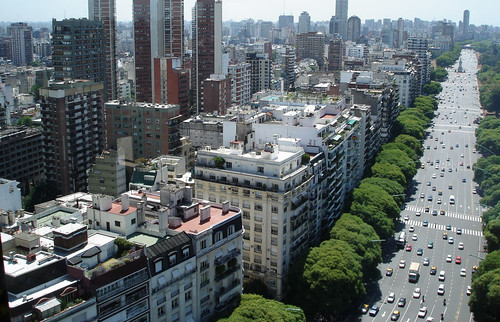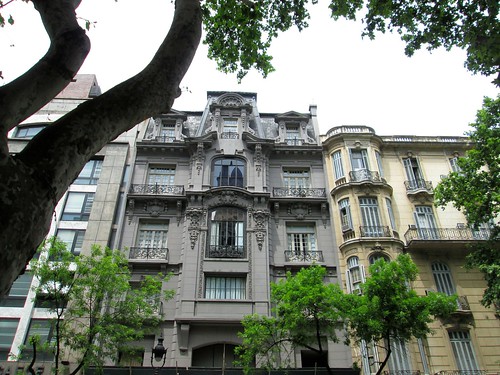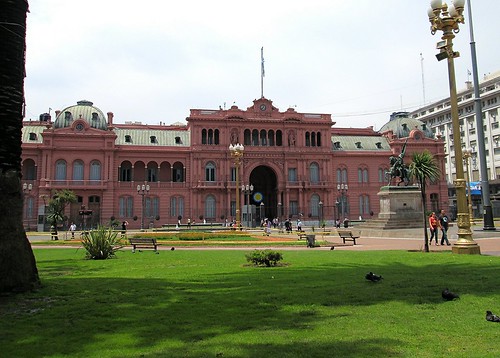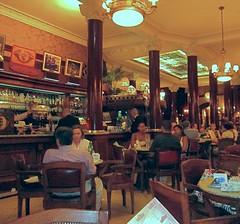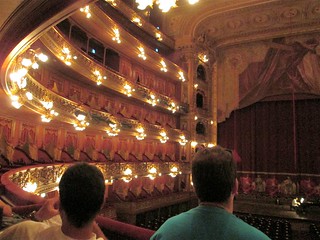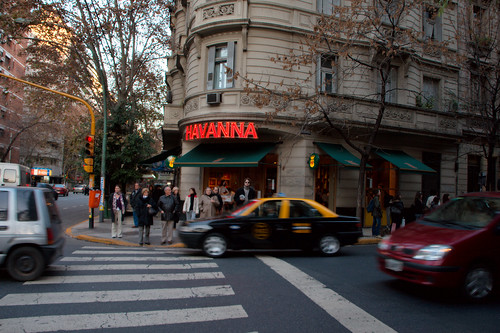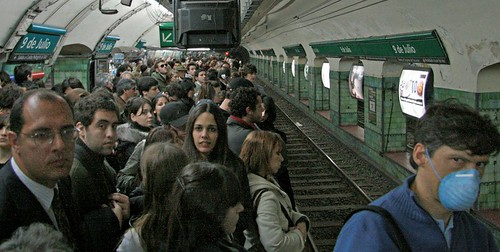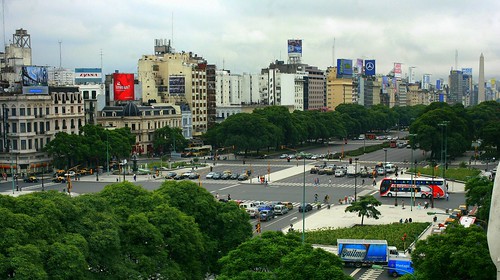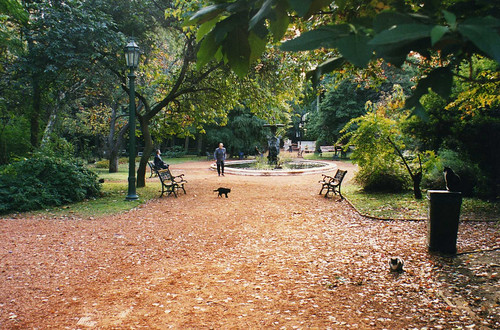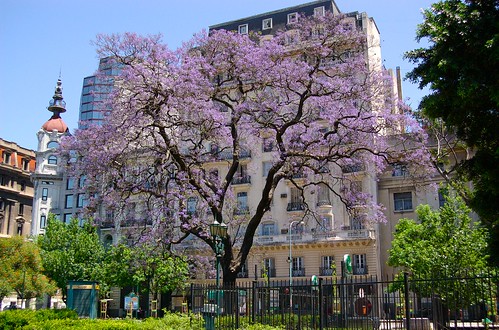Could Buenos Aires be a model for thinking about US cities? (by Lee Epstein)

Posted January 10, 2013 at 1:32PM
Today’s article is guest-authored by my friend and frequent collaborator, Lee Epstein, an attorney and land use planner working for sustainability in the mid-Atlantic region of the US. He last appeared here in November, in an article we wrote together, Sandy as preview: making communities more resilient to severe climate events.
Lee recently traveled to Argentina, the subject of today’s contribution:
Buenos Aires, the capital of Argentina, has a metro area population of 12 million people, making it the second largest metropolis in South America. The city is situated at the lazy, braided mouth of an estuary (the Rio de la Plata) formed by the confluence of the mighty Paraná and Uruguay Rivers. (At more than 3,000 miles/4,880 km long, the Paraná is the second longest river on the continent after the Amazon, with a watershed of more than a million square miles.) With a temperate but humid climate, the Argentine capital (“BA”) never gets too cold in the winter but can be really hot and sticky in the summer. From December through February, it can be uncomfortably hot, but my family and I were there in mid-spring (early November), enjoying near-perfect weather.
Considering cities through the lenses of urban function and sustainability is in my blood, so while in BA – and especially since returning – I’ve been thinking about what makes the city work. Are there things about Buenos Aires that can inform us, one way or another, as we consider urban environments in the US?
Buenos Aires’s urban assets
There is certainly a lot to like. The city has dozens of unique neighborhoods (barrios), from the upscale Recoleta and Palermo Soho, to the funky, edgy San Telmo and La Boca. (There are, of course, some pretty rough and unremarkable neighborhoods as well.) There is not much colonial era architecture left, but BA’s 19th century, European-styled, three- to ten-story buildings are beautiful, featuring large windows and balconies with iron grill-work, sometimes overlooking tree-lined streets; many of these (thankfully) seem to be undergoing renovation. Major cultural institutions, such as the Teatro Colon, one of the world’s premier opera houses, are sumptuous.
The city has an incredibly wide central boulevard (Avenida 9 de Julio), intersecting with another monumental street (Avenida de Mayo) that connects the president’s home and offices (Casa Rosada) with the home of the National Congress (Palacio Congreso). These central features, with their parks and squares and fountains – and an obelisk – memorialize a rich if somewhat unsettling past.
Some Porteños (as BA residents call themselves, since they reside in a major port city) gather at these places regularly to protest and argue about politics -- which is one of several major passions; we happened to witness the remnants of a demonstration of veterans who served during the Malvinas/Falklands war, seeking benefits. Another major passion is very good coffee, celebrated in a relaxed way in (literally) thousands of neighborhood coffee houses; some are dark, wood-paneled beauties, like the Café Tortoni, classic and culturally venerable. A third passion is tango, as practiced and performed in a range of venues from neighborhood tango clubs (milangos) to national competitions. And the fourth great passion is, of course, futbol – soccer to us. (Lionel Messi, the current and four-time winner of the Ballon d’Or as the world’s best player, is from Argentina and plays on the national team when he isn’t with his pro team, European champion FC Barcelona.) I’d definitely be hesitant to put these passions in any order.
Porteños walk a lot, very fast and often on crowded sidewalks, and the transit system (colectivos or buses, and the Subte or subway) can get you anywhere, cheaply (though you’ll wait in long lines and often stand in those crowded buses during morning and evening rush hours). There also seem to be about 6 million taxis in the city – and they don’t so much drive as perform a sometimes dizzying arabesque, based on a liberal use of the horn and 1 ½ - 2 ½ cars per “lane.”
Finally, and literally, the city never sleeps. A few shops and restaurants close for a long lunch when some residents rest at home, but most in this busy capital city don’t. Dinner is a leisurely affair, usually beginning between nine and ten in the evening. Many restaurants, bars and clubs are open until six in the morning, and it’s not unusual to find throngs of young people returning home from a long evening out as the sun rises on a fresh Saturday morning above the Rio de la Plata.
The presence of a great city
There is something intangible about the “presence” of a great city. It throbs with life, its people are busy and moving, but the culture also supports moments -- sometimes long moments -- at a much-reduced pace, as well as places in which to savor that experience: for example, the corner coffee houses, or the hundred parks and plazas, riverfront greens, open markets, and pedestrian-oriented, tree-lined places to stroll that are found in BA. Great cities may undoubtedly be big, sometimes noisy, busy, and very urban places; but thoroughly integrated within them are various-sized green spaces for rest and shade and play; in the case of BA, many of them enjoy access to he river.
What about the neighborhood scale? Again, BA’s many walkable districts have the right characteristics. Indeed, they are often complete in and of themselves, with medical clinics and lawyers, restaurants and small food markets, pharmacies and the kinds of small businesses helpful to daily living. This is enabled in Buenos Aires because land uses are often mixed, or at least nearby as largely commercial streets are just a block or two from largely residential ones. Schools and day care centers are found in the neighborhoods, too, and usually a nice park or square. The commercial and residential diversity yields some resilience to changing economic conditions.
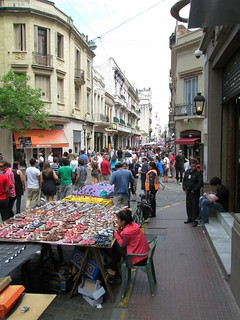 I have no illusions, though. There is some stark economic segregation by neighborhood, such as exists in every major city in the world. Some neighborhoods mix incomes better than others, but the physical fabric of poorer areas (infrastructure, housing quality, commerce and services) still suffers greatly from decades of neglect. While BA has many of the features of a modern European city, Argentina is still in the midst of overcoming a colonial, kleptocratic past and these areas require urgent attention.
I have no illusions, though. There is some stark economic segregation by neighborhood, such as exists in every major city in the world. Some neighborhoods mix incomes better than others, but the physical fabric of poorer areas (infrastructure, housing quality, commerce and services) still suffers greatly from decades of neglect. While BA has many of the features of a modern European city, Argentina is still in the midst of overcoming a colonial, kleptocratic past and these areas require urgent attention.
(Even with the income disparity, there is a degree of mixing: because the city’s public life is rich, old and young, rich and poor cross paths daily. Portenos of all social classes share traditions such as family walks in the park, watching soccer leagues on weekends, enjoying coffee at a corner café, or watching or participating in tango.)
Importantly, BA’s architectural scale is conducive to walkability. While there are tall buildings along main commercial streets, as well as scattered high-rises (many of the most modern are in a reinvigorated commercial neighborhood along the docks, called Puerto Modero), for the most part this city is highly dense but moderately scaled, the residential and commercial buildings retaining an intimate, proportional relationship with their streets. A critic might call these rows of 6-10 story buildings squat and blocky (a complaint raised by some about Washington, DC, which I don’t share), but they are often quite elegant, and there is an undeniable pedestrian comfort in their dimensions. In many of the neighborhoods, walkable density is achieved with buildings of only three and four stories, fronting on narrow streets -- reminiscent of the best tight neighborhoods in Boston, Chicago, Philadelphia, San Francisco, and New York.
As noted above, public transport is easy, plentiful, relatively cheap, and ubiquitous. Walking and biking are also common modes of choice (BA has a growing bike lane system). Of course, there are still tens of thousands of cars and there is crazy traffic – this is a major city still transitioning. Like others of its ilk it sometimes eschews the careful orderliness of traffic on most US streets. But there are good alternatives to driving everywhere, and they are heavily used by everyone, in part because fuel is so expensive but also because these alternative modes are safe, readily available, and get you where you need to go.
Residents of BA also harbor an awareness of the cultural importance of the vast Argentine countryside (although see below). In at least one way, private enterprise is helping to conserve the extensive pampas (extremely productive farm, ranch and rangeland) with an extensive system of agro-tourism called estancias (basically “dude ranches” that range widely as to size, type, cost and services) that are hosts to both Argentines and foreigners seeking a country respite. These add substantial income and incentives for continued agricultural and ranch use.
Causes for concern
The province (versus the city) of BA is absolutely huge, covering almost 119,000 sq mi (more than 307,000 sq km) – bigger than Italy (though not as big as California). Much of this land area comprises the pampas and the country’s popular Atlantic beaches; both are crucial components of the Argentine economy and, to Argentines, major parts of their self-identity. But, while there is thus some incentive to protect and preserve these areas, there are also forces at work that are sadly consuming them with suburban and exurban sprawl at the metropolitan area’s (and numerous municipalities’) extensive edges.
Until recently, the periphery of the city of Buenos Aires was lined with low-income settlements (and highly polluted rivers) that were only slowly growing in land area. These included small and informal loteos populares without services.
In more recent years, however, American-style suburbanization has proliferated. Gated communities and privately planned “cities” now appear on the mostly flat, extraordinarily fertile landscape outside of the city. This haphazard suburbanization continues to eat away at BA’s vast pastoral surroundings of working farm and ranchland – pushing it farther and farther away, threatening eventually to sap energy and investment from the province’s towns and BA’s city center.
These newer, sprawling suburbs are highly (indeed, solely) managed by the private sector, for the exclusive benefit of high and middle-income populations. This is enabled by highly fragmented and uncoordinated legal authority (as between municipalities and the province), and an immature to non-existent process for land use planning and management. While there are signs of awareness of these problems (at mid-decade the national government proposed the creation and implementation of land use plans in all Argentine provinces), progress is very slow, at best. Changes in land management law and practice are very much needed.
Beyond land use, national politics are not helping to solidify a sustainable future for metro BA and its residents. In particular, I believe the aspirations of lower-income Argentines may be threatened by the form of populism espoused by the current president, which is so insular and protective as to restrict or repel foreign investment. As a result, many consumer goods from other countries may become so expensive as to keep them out of the hands of everyone but the very wealthy. I suppose the “good” news on this front is that elections are but a few short years away.
Lessons north and south
From my perspective as a committed urbanist, Buenos Aires was fascinating. I believe that many of its good features are, in fact, transferable to North American cities as many in the US and Canada seek to re-urbanize: the parks and plazas, the lively public life, the many “third places,” the rich menu of transportation choices, the relatively complete neighborhoods, the pleasant scale and walkable streets. The resulting urban form or practice that we create in our own country of course won’t be precisely the same as in BA, but there is still much to learn from another culture as our own cities grow and change.
At the same time, BA clearly needs stronger land use authority. This is an area in which US municipalities and states are superior, if only in theory: our problem, of course, is that few US jurisdictions actually use the authority that they have, or use it in perverse ways that thwart sustainability. As a result, our reality on the ground is that we have become all too good at making the worst of problems that are now beginning to show ill effects in BA, including lack of coordination among adjoining jurisdictions, the politics of development money, poor or absent planning and land use management, and resulting sprawl. Just as we in the US might do well to look south for some things to emulate, residents and leaders of Buenos Aires might do well to look north to see what they should try harder to avoid.
Related posts:
- From elephant to estuary: does the 2013 European Green Capital have something to teach US cities? (December 17, 2012)
- Can US communities learn from this European suburban retrofit? (February 22, 2012)
- How Hamburg became the (2011) European Green Capital (November 21, 2011)
- Australia outlines national city design principles (November 2, 2011)
- Rebuilding Haiti, quickly and thoughtfully (February 16, 2010)
- Revitalization in the third world: Rose Town, Jamaica explores healing through restoration (October 7, 2009)
Move your cursor over the images for credit information.

